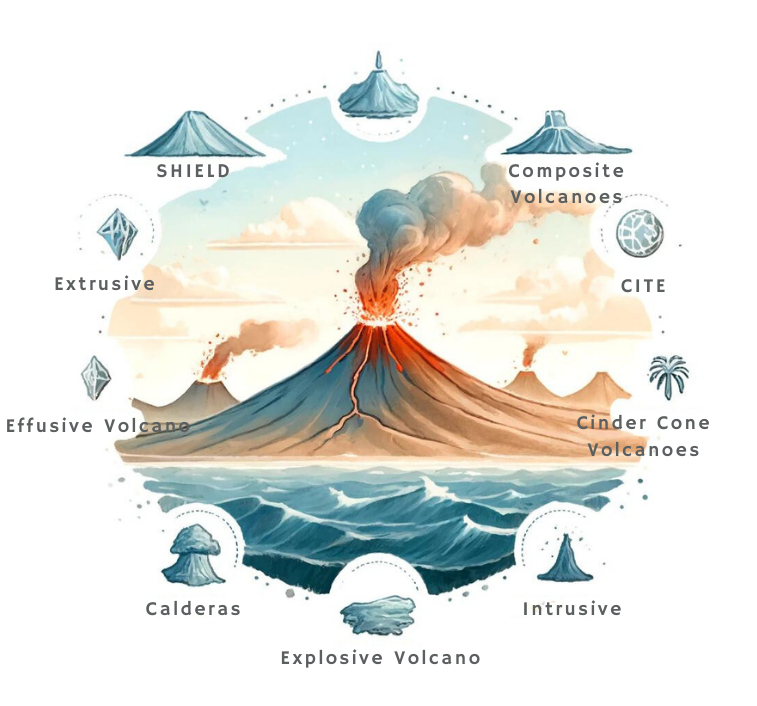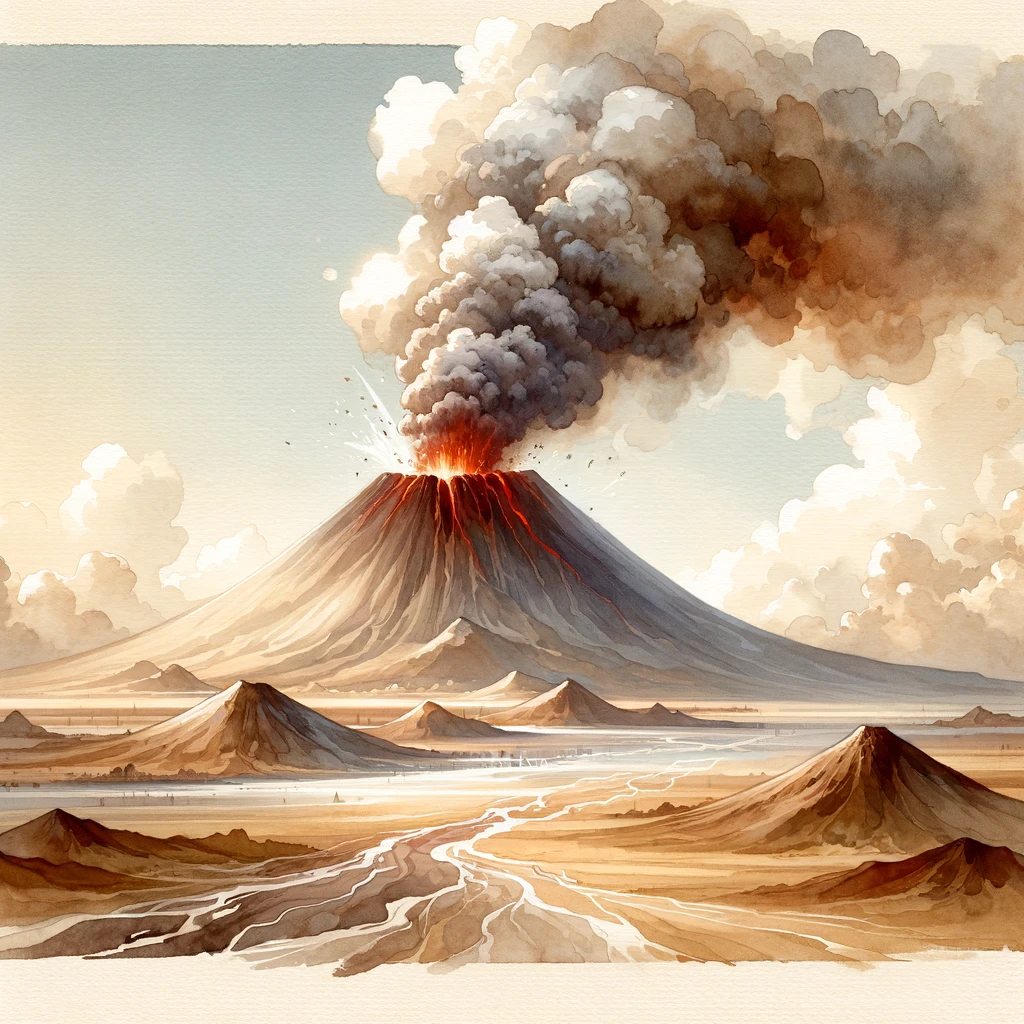Volcanoes are interesting natural phenomena characterized by the effect of molten rock, gas, and ash that seep out from under the Earth’s crust. In most cases, it takes place close to the boundaries of tectonic plates. The eruptions of such volcanic features change the landscape surrounding the area. The eruptions vary from gentle lava flows to explosive events that can even mold whole regions. Here are some of the most important facts related to volcanoes:
- Volcanoes are formed when magma of the Earth’s mantle comes up to the surface through cracks in the Earth’s crust.
- They can inflict massive damage, including lava flows, ash clouds, and pyroclastic flows, related to nearby communities.
- Some volcanoes have remained dormant for millennia while others are eruptive and continuous in causing geological changes.

Classification of Different Types of Volcanoes
Volcanoes can be categorized according to their shape, style of eruption, or activity. The four principal types consist of shield volcanoes, stratovolcanoes, cinder cones, and lava domes. Volcanoes can be classified based on their shape, eruption style, and the composition of their magma. The main types include:
Shield Volcanoes
- Features: Broad, gently sloping cones built by the flow of low-viscosity basaltic lava.
- Examples: Mauna Loa and Mauna Kea in Hawaii.
- Eruption Style: Non-explosive eruptions with lava flows covering large areas.
Stratovolcanoes (Composite Volcanoes)
- Features: Steep, conical volcanoes composed of alternating layers of lava, ash, and volcanic rocks.
- Examples: Mount Fuji in Japan, Mount St. Helens in the USA.
- Eruption Style: Explosive eruptions due to the higher viscosity of andesitic to rhyolitic magma.
Cinder Cone Volcanoes
- Features: Small, steep-sided cones made primarily of volcanic ash, cinders, and bombs.
- Examples: Parícutin in Mexico, and Sunset Crater in the USA.
- Eruption Style: Short-lived, explosive eruptions that produce pyroclastic fragments.
Lava Domes
- Features: Dome-shaped, steep-sided mounds formed by the slow extrusion of viscous lava.
- Examples: Novarupta in Alaska, Mount St. Helens Lava Dome.
- Eruption Style: Effusive eruptions that can produce pyroclastic flows if the dome collapses.
Caldera Volcanoes
- Features: Large, basin-like depressions form when a volcano erupts and collapses into the emptied magma chamber.
- Examples: Yellowstone Caldera in the USA, and Krakatoa in Indonesia.
- Eruption Style: Catastrophic eruptions that can release massive amounts of magma and pyroclastic material.

Mechanisms Driving Volcanic Activity
Volcanic activity would, therefore likely be driven by the movement through the crust by tectonic plates, magma pressure building up beneath the Earth’s surface, and also due to the bursting of gases that usually lead to eruptions and shaping of landscapes with resultant effects on ecosystems. Volcanic activity is driven by several geological processes related to the movement and interaction of tectonic plates. The primary mechanisms include:
Subduction Zones
- Process: One tectonic plate is forced down into the mantle under another, where it melts to form magma.
- Outcome: Magma erupts, forming explosive stratovolcanoes above the surface.
Rift Zones
- Process: Tectonic plates diverge, and the mantle upwells to create magma.
- Outcome: Shield volcanoes and fissure eruptions are the products of this process established at mid-ocean ridges.
Hotspots
- Process: Tectonic plate boundaries are independent of Plumes of hot mantle material rise.
- Outcome: Breakthrough to the crust forms shield volcanoes, as with Hawaii and Yellowstone.
Mantle Plumes
- Process: Buoyant plumes of hot mantle material rise towards the crust.
- Outcome: These plumes create volcanic islands and large igneous provinces, often associated with intense volcanic activity.

Environmental and Climatic Effects of Volcanic Eruptions
Volcanic eruptions significantly affect the environment and climate through ash, gases, and aerosol dispersions in the atmosphere. The emissions caused by them lead to cooling, interference with ecosystems, and changes in global weather patterns.
Local Environmental Impact
- Lava Flows: Destroy vegetation and infrastructure and can reshape landscapes.
- Ash Falls: Can devastate crops, contaminate water supplies, and cause respiratory problems for living beings.
- Pyroclastic Flows: Fast-moving currents of hot gas and volcanic matter can obliterate anything in their path.
Climatic Effects
- Volcanic Gases: Eruptions release gases like sulfur dioxide (SO₂), which can form sulfate aerosols in the stratosphere, reflecting sunlight and cooling the Earth’s surface.
- Ash and Particles: These can also reflect sunlight, leading to a temporary cooling of the climate.
- Long-Term Impact: Significant eruptions can influence global climate patterns, potentially causing years of cooler temperatures.

Conclusion
Vlcanoes are a witness to the dynamic nature of Earth’s interior. Understanding the type of eruptions, mechanisms, and processes on which their activities are based and effects on their environment is very important for the mitigation of risks and preparation for potential future eruptions. For UPSC aspirants, studies into these areas are very significant because they give a holistic understanding of one of the most powerful geological processes on Earth.
| Volcanoes UPSC Notes |
| 1. Volcanoes are openings in the Earth’s crust that allow molten rock, ash, and gases to escape from below the surface. 2. There are three main types of volcanoes: shield volcanoes, composite volcanoes, and cinder cone volcanoes, each with distinct characteristics. 3. Volcanic activity is primarily found along tectonic plate boundaries, particularly in the Pacific Ring of Fire, accounting for 75% of the world’s active volcanoes. 4. Volcanic eruptions can have both destructive and constructive impacts, including the formation of new land and fertile soil but also causing earthquakes and tsunamis. 5. The Volcanic Explosivity Index (VEI) measures the explosiveness of eruptions on a scale of 1 to 8, based on factors like volume of ash and duration. 6. Some of the most active volcanoes include Mount Etna in Italy, Kilauea in Hawaii, and Mount Merapi in Indonesia. 7. Volcanic eruptions can influence global climate by releasing large quantities of ash and gases, which can lower temperatures through the formation of aerosols. 8. Understanding volcanic activity is crucial for disaster preparedness, as areas like Japan, Indonesia, and the Philippines are particularly vulnerable due to their tectonic settings. |



